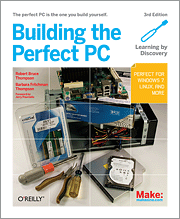Building the Perfect PC by Thompson and Thompson (a Book Report)
 Building the Perfect PC, Third Edition by Robert Bruce Thompson and
Barbara Fritchman Thompson is written for anyone who’s tired of buying
off-the-shelf computers and is ready to go the DIY route. I think that’s
great—building a computer is educational, gratifying, and, with
the right guidance, can even be fun. Unfortunately, I don’t know if this
book provides that kind of guidance.
Building the Perfect PC, Third Edition by Robert Bruce Thompson and
Barbara Fritchman Thompson is written for anyone who’s tired of buying
off-the-shelf computers and is ready to go the DIY route. I think that’s
great—building a computer is educational, gratifying, and, with
the right guidance, can even be fun. Unfortunately, I don’t know if this
book provides that kind of guidance.
I’m not a newcomer to building and maintaining computer hardware. I’ve built big servers, little servers and desktop PCs; and for years kept an old Macintosh G4 plugging along well after its prime through systematic upgrades to pretty much every component except its motherboard and power supply. I’d been thinking about a home server to handle backups and a little file sharing, and figured I’d give Building the Perfect PC a shot before buying something off-the-shelf. I purchased the recommended components for a home server and sat down to assemble it last week. More on my results in a moment.
In the book, Thompson and Thompson cover building a budget PC, a mainstream PC, a high-end PC, a media center, an Internet PC, and the aforementioned home server. Each project is documented with a list of components (with rationale) followed by step-by-step instructions. The projects are well-documented with photographs, checklists, and potential gotchas. The photographs are high quality and should, in theory, be sufficient to walk readers through the process from start to finish.
However, I have three major issues with Building the Perfect PC. First, I feel like if you read this book any later than a few months after its November 2010 publication date, the recommended components lists are going to be out of date. Second, although the building procedures for each type of computer are thoroughly documented, due to variations in the same components they recommend, some of the steps and corresponding photos aren’t correct. If you’re a newcomer to building PCs, and just spent a few hundred dollars on parts, and have read in multiple places that connecting a power supply or fan incorrectly can damage your investment, this might be disconcerting. Finally, the authors spend way too much time preaching the merits of DIY PC building, to the point that much of their proselytization is repeated in just the first couple of chapters. The why could have been covered in much less space to give more room for content for readers new to PC building.
Long story short: I still don’t have a server. I had to order more cables. My theory is that Thompson and Thompson got some of their existing inventory of extra parts and cables mixed up with what came with the components purchased for the project. I’m hopeful that sometime next week I’ll be up and running, but I’d be lying if I didn’t say that right now I’m feeling some buyer’s remorse on this whole project. To be fair, my experiences are based on just one of the six projects offered in the book, but that doesn’t make them any less frustrating.
Ultimately, I’m not sure for whom Building the Perfect PC is intended—it’s probably too basic for anyone who’s built a computer before, and might make too many assumptions for first-timers. For the former, reading up on the latest components through industry blogs or periodicals would do the trick (the components in this book are apt to be last year’s options by the time you pick it up), and for the latter, a book with some kind of glossary or primer up front might be a better way to go.
More information about Building the Perfect PC is available from O’Reilly.
Note: I wrote this review for O’Reilly’s Blogger Review Program. It’s a pretty nice deal: Get a free e-book to read, share a review in your blog, get another free book to read. Sign up for yourself to take advantage of this deal, and watch for more book reports in my blog.
. Questions or comments? Let me know what you think.